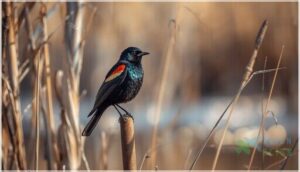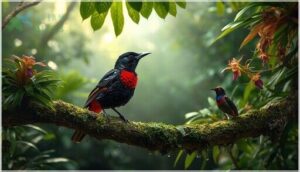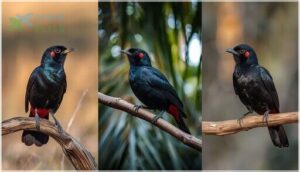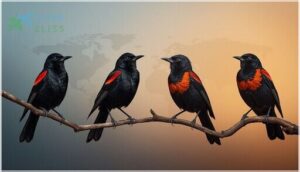This site is supported by our readers. We may earn a commission, at no cost to you, if you purchase through links.
You spot a flash of crimson against glossy black feathers at your backyard feeder, and for a moment you’re certain you’ve seen something exotic. Black birds with red chest markings aren’t rare—they’re just masters of disguise, often overlooked because we assume we already know what we’re seeing.
That scarlet patch transforms a common songbird into something that stops you mid-step, binoculars half-raised. These striking species span continents, from North American meadows to South American rainforests, each wearing their red badge in a slightly different pattern. Some sport a modest splash of color while others flaunt a crimson bib that catches sunlight like a signal flare.
The secret to identifying them lies in reading the subtle differences that separate one species from another.
Table Of Contents
- Key Takeaways
- What Defines Black Birds With Red Chest?
- Common Species Across The Globe
- Identifying Features and Field Tips
- Habitat and Geographic Distribution
- Diet and Feeding Habits
- Migration Patterns and Social Behavior
- Conservation Status and Protection
- Frequently Asked Questions (FAQs)
- What are black birds with red chests?
- What does a red chest bird look like?
- Why do birds have red chests?
- What birds are red and black?
- What is a blue bird with a red chest?
- What is a red-breasted blackbird?
- What kind of bird is black with a red chest?
- Why are redwing blackbirds so aggressive?
- Where do red-breasted blackbirds live?
- Is it rare to see a red-winged blackbird?
- Conclusion
Key Takeaways
- Black birds with red chest markings span multiple continents and species, with males displaying more vibrant crimson patches than females—these markings evolved as powerful genetic signals advertising health and breeding readiness during mate selection and territorial disputes.
- Accurate identification requires observing three key features: the extent of black plumage coverage, the specific pattern and intensity of red chest coloration (ranging from small patches to extensive bibs), and beak shape adapted to their omnivorous diets of seeds and insects.
- North America hosts the highest diversity of these species, particularly the Red-winged Blackbird with red shoulder epaulets rather than chest patches, while South American tropical forests showcase species like the Masked Crimson Tanager with true red breasts—though many field guide claims about African and Asian species reflect misidentification rather than genuine red-chested variations.
- Conservation threats including habitat loss, pesticide exposure, and climate-driven timing mismatches between breeding season and food availability require active intervention through native plantings, window collision prevention, and protected area expansion to ensure population survival.
What Defines Black Birds With Red Chest?
When you spot a bird with dark plumage and a splash of red across its chest, you’re seeing one of nature’s most eye-catching color combinations. These striking birds aren’t just a single species—they’re found across multiple continents, each with unique markings that serve specific purposes in their survival and reproduction. Birds with black plumage and red chest markings are among the most visually stunning species, and these striking red and black birds inhabit diverse ecosystems worldwide.
To identify them accurately, you’ll need to understand three essential features that separate one species from another. To identify them accurately, you’ll need to understand three essential features that separate one species from another, especially when observing common backyard bird species in your area.
Key Physical Characteristics
You’ll notice these black birds with red chests share striking feather patterns that make bird identification surprisingly straightforward once you know what to look for. Whether you’re tracking a small black bird with a red chest in your backyard or studying a red-breasted blackbird in wetlands, here’s what sets them apart: These vibrant species, along with small birds with red heads, create stunning visual displays across North American habitats.
- Black Plumage Coverage – The deep black coloring usually extends across the body, wings, and tail, creating that striking contrast you can spot from a distance.
- Red Chest Markings – These vary from small patches to extensive bib-like displays across the upper chest, with males usually showing more vibrant hues.
- Beak Shapes – You’ll find stout, pointed beaks adapted for their omnivorous diets, perfect for cracking seeds and catching insects.
- Size Range – From tiny songbirds to medium-sized passerines, their proportions help them blend into dense habitats or stand out when needed.
- Color Variations and Plumage Texture – The red can range from rusty-orange to deep crimson, while feather texture affects how light plays across their bodies, making some species appear glossier than others.
The wing structure also plays a role in identification, though it’s less obvious than chest coloring. Watch how they fly—some species have rounded wings for quick maneuvers through trees, while others show longer, more pointed wings built for migration. Understanding scientific study methods is essential for accurate bird identification and research.
Significance of Red Chest Markings
Those red chest markings aren’t just for show—they’re powerful signals shaped by red signal evolution and red plumage genetics. Males flash their crimson patches during mate attraction strategies, turning chest color variation into visual communication that says “I’m healthy and ready to breed.” Males use vibrant red chest feathers as powerful visual signals during courtship displays to advertise their genetic fitness and breeding readiness.
Red chest markings evolved as powerful genetic signals males use to advertise health and breeding readiness to potential mates
You’ll see redbreasted blackbird species use these displays to claim territory and win over females, making bird identification easier when you understand the science behind the spectacle. Red-breasted blackbirds use their vivid shoulder patches during territorial displays in wetlands to attract mates and defend prime breeding spots.
Male Vs. Female Coloration
Now here’s where sex-linked traits really matter. Males sport vivid red chests thanks to hormonal influence and genetic factors driving color dimorphism, while females wear subdued browns or faint speckling.
This plumage variation helps you nail bird identification—brighter males attract mates and defend turf, while cryptic females stay safe at the nest.
Understanding these bird species characteristics unlocks the secrets of avian behavior and social structure.
Common Species Across The Globe
You’ll find black birds with red chests scattered across every major continent, each region hosting its own unique species with distinct markings and behaviors. North and South America claim the highest diversity, while Africa, Asia, and Australia offer their own striking variations.
Let’s break down these gorgeous birds by their geographic homes so you can identify what’s flying through your neck of the woods.
North American Black Birds With Red Chest
When you spot a glossy black bird flashing crimson in a marsh, you’re likely seeing one of North America’s most striking species. Here are the primary black birds with red chest markings you’ll encounter:
- Redwinged Blackbird (Agelaius phoeniceus) – Males display vivid red-and-yellow shoulder patches, not chest coloring, making them easy to identify during territorial displays.
- Tricolored Blackbird – Similar red shoulder badges distinguish this California native.
- Brewer’s Blackbird – Lacks red chest entirely; glossy black throughout.
- American Robin – Gray-brown back with orange-red breast; not truly a black bird with red chest.
These species inhabit marshes, wetlands, and meadows across the continent, with migration routes spanning Alaska to Panama.
South American Black Birds With Red Chest
In South America’s tropical forests, you’ll find striking red chest variations among black birds that rival any northern species. The Masked Crimson Tanager and Crimson-collared Tanager showcase glossy black plumage with vivid red breasts, thriving in riparian woodlands.
The Red-breasted Chat and Crimson-breasted Finch display similar coloration, while the Scarlet Tanager migrates between continents, connecting South American taxa with familiar North American bird species.
African, Asian, and Australian Species
You’ll find that accurate bird identification in Africa, Asia, and Australia requires caution—many dark-plumaged species show red throat or rump tones rather than true red chest variations. Regional plumage and lighting conditions often create species misidentification.
Black birds with genuine red chest coloration patterns remain rare across these continents, despite field guide claims. Taxonomic revisions continue clarifying avian diversity and refining species identification standards.
Global Examples and Variations
Across continents, you’ll notice that red chest variations in black birds reveal fascinating regional adaptations and color morphs shaped by local environments and genetic drift. Taxonomic classifications continue evolving as ornithology uncovers new patterns in bird identification and global species distribution.
- North America’s Red-winged Blackbird displays red shoulder epaulets rather than chest patches, a common bird identification confusion
- South American populations show red underparts with variable intensity across subspecies ranges
- Color polymorphism creates occasional red-chested individuals outside typical morph distributions within species
- Hybridization zones produce intermediate plumage patterns that challenge traditional bird species classifications
Identifying Features and Field Tips
Spotting these red-chested beauties in the field takes more than a quick glance at color alone. You’ll need to pay attention to subtle details like plumage patterns, vocalizations, and how these birds move through their environment.
Let’s break down the key features that’ll help you nail your identification every time.
Visual Markers and Plumage Details
When you’re trying to nail down bird identification in the field, plumage patterns are your best friend. Look for that bright red chest patch—often crescent-shaped—bordered by glossy black throat and mantle feathers. Male small black birds with red chests generally show more saturated color than females.
Feather texture varies from velvety to glossy, creating striking iridescence effects that help distinguish different bird species at a glance.
Song, Calls, and Behaviors
Listening to vocalizations sharpens your bird identification skills faster than you’d think. Males belt out melodic whistles and varied chirps during territorial singing, establishing boundaries through dawn choruses. You’ll hear sharp alarm calls when predators approach, plus soft contact notes that keep flocks coordinated.
Song structure reveals surprising vocal learning abilities across bird species, helping ornithologists decode bird communication patterns and understand avian ecology in real time.
Seasonal Plumage Changes
You’ll notice chest coloration shifts dramatically with the seasons, making bird identification trickier than you might expect. Breeding plumage peaks mid-to-late spring when hormonal regulation intensifies those striking red chest markings for mate attraction. Here’s what seasonal cues reveal about feather molting and plumage variation:
- Spring brings vivid color shifts in small black bird with a red chest species, enhancing territorial displays
- Late summer triggers eclipse plumage with duller tones
- Juvenile avian bird species show mottled patterns before their first adult molt transforms bird behavior
Habitat and Geographic Distribution
Knowing where to find these striking birds can make all the difference when you’re out in the field. Black birds with red chests occupy surprisingly diverse landscapes, from dense woodlands to open marshes, and their ranges span entire continents.
Let’s break down the specific environments they prefer, where they show up across different regions, and whether you’re more likely to spot them in your backyard or out in wilder territory.
Preferred Environments
You’ll spot these striking birds where food meets shelter—wooded edges, shrubby meadows, and surprisingly, urban landscapes with green corridors. Habitat selection hinges on breeding grounds rich in insects and fruit, which shifts with migration routes.
Forest ecology and bird habitat preservation matter here; these species thrive when environmental awareness meets ecological balance. Understanding their conservation status helps you protect the places they need most.
Regional Distribution Patterns
You’ll find geographic isolation shapes where these birds settle—North America’s eastern deciduous forests hold thriving populations, while South America’s Amazon Basin and Atlantic Forest provinces showcase regional endemism. Sub-Saharan Africa’s savanna-woodland mosaics support different species altogether.
Climate influence and habitat fragmentation carve distinct bird migration patterns across continents, revealing how ornithology maps ecological balance through bird species distribution and habitat and distribution studies.
Urban Vs. Rural Occurrences
Urban density often misleads birdwatchers—cities show higher sightings because more observers and feeders boost detection rates, not necessarily because populations thrive there. Rural migration zones and agricultural landscapes host seasonal aggregation during harvest, creating temporary spikes. Habitat fragmentation affects roosting patterns differently across settings, so understanding these bird migration patterns helps with accurate bird identification.
- Temperate cities attract small black bird with a red chest species through ornamental plantings and artificial water sources
- Rural territories offer larger foraging ranges with natural food resources during breeding seasons
- Reporting bias skews habitat and distribution data—urban areas have more active birdwatchers
- Agricultural edge habitats create transient congregation points for insectivorous black bird species
- Fragmented urban zones may reduce stable nesting compared with adjacent rural habitats
Diet and Feeding Habits
Understanding what these birds eat reveals a lot about how they live and where you’ll find them. Their feeding habits shift with the seasons, and different species have developed some pretty clever ways to find their meals.
Let’s break down their typical food sources, how they hunt and forage, and why their diets change throughout the year.
Typical Food Sources
You’ll spot these birds working through food chains with surprising versatility. During the breeding season, they hammer through protein-rich invertebrates like caterpillars and beetles, while seed consumption from weeds and grasses sustains them through winter.
Backyard bird feeders stocked with black oil sunflower seeds draw many species, and birdwatching enthusiasts notice their enthusiasm for nectar feeding, insect foraging, and raiding local fruit sources from shrubs to backyard trees.
| Food Type | Peak Season | Common Examples |
|---|---|---|
| Invertebrates | Spring-Summer | Beetles, caterpillars, ants |
| Seeds | Fall-Winter | Grasses, weeds, sunflowers |
| Fruits | Year-round | Berries, fallen orchard fruit |
| Nectar | Migration | Flowering plants, garden blooms |
Foraging Behaviors
Watch these birds work their hunting magic through contrasting prey capture and seed gathering tactics. Their foraging techniques reflect impressive adaptations honed across generations.
Foraging Strategies:
- Gleaning from foliage and bark – You’ll catch them carefully extracting arthropods from tree surfaces during bird watching excursions.
- Ground foraging – They opportunistically pick seeds from leaf litter with surgical precision.
- Short-distance chases – Some species flush prey through conspicuous pursuit behavior.
- Visual cue exploitation – Contrasting chest markings aid bird identification and conspecific food source location.
These foraging adaptations support wildlife conservation understanding.
Seasonal Dietary Shifts
Throughout the year, you’ll notice distinct changes in what these black bird species consume as seasons shift. Their dietary flexibility allows impressive adaptation between abundant insect populations during breeding and seed-heavy winter feeding strategies.
| Season | Primary Food Source | Foraging Focus |
|---|---|---|
| Spring/Summer | Insects (grasshoppers, beetles) | Active pursuit, gleaning |
| Autumn | Mixed seeds, berries, remaining insects | Ground foraging, fruit trees |
| Winter | Seeds, grains, limited arthropods | Surface gleaning, agricultural fields |
| Migration | High-energy fruits, protein-rich prey | Opportunistic feeding, diverse sources |
This seasonal foraging pattern aids migration nutrition demands and demonstrates food source adaptation critical to bird behavior studies and wildlife conservation efforts in ornithology studies.
Migration Patterns and Social Behavior
These red-chested birds don’t just stick to one spot—many species travel impressive distances throughout the year, following ancient routes that take them between breeding and wintering grounds. Understanding when and where they migrate helps you predict sightings in your area, while observing their social habits reveals how they interact within flocks and claim territories.
Let’s break down their movement patterns, group dynamics, and breeding behaviors so you know what to expect in the field.
Migration Routes and Timing
You’ll witness these bird species following distinct flyway patterns tied to food availability and seasonal movements. North American populations migrate late March through early May, while South America’s birds show altitudinal shifts during September to December.
Migration cues include insect emergence and fruit pulses. Some species cross deserts and seas along major continental corridors, using critical stopover sites.
Understanding avian ecology helps support wildlife conservation efforts protecting these extraordinary journeys.
Flock Behavior and Social Structure
You’ll see these black bird species organize themselves into complex social hierarchies that shape every moment of flock life. Dominance roles determine who eats first and where individuals perch, while cooperative breeding brings helpers to the nest.
- Stable group membership persists across seasons, with repeated interactions building long-term social bonds
- Synchronized foraging reduces predation risk as experienced birds lead others to productive feeding sites
- Shared sentinel duty emerges naturally, with certain individuals watching for threats while others feed
- Social network position predicts future reproductive success, making flock dynamics vital for wildlife conservation
Breeding Season Dynamics
When you observe breeding cycles in black birds with red chests, photoperiod triggers hormonal shifts that launch mating rituals. Males intensify territorial behavior through song and vivid courtship displays, defending nest sites while females regulate incubation timing.
Nesting strategies reflect predator avoidance, with concealed locations boosting fledgling success. Understanding these avian ecology patterns sharpens your bird identification skills and reveals how bird behavior adjusts to local climate and food abundance.
Conservation Status and Protection
These striking birds face real challenges in the wild, from shrinking habitats to climate shifts that disrupt their breeding and migration cycles. Understanding what threatens them helps you see why conservation work matters so much.
Let’s look at the main risks they’re up against, what’s being done to protect them, and how you can make a difference in your own backyard.
Threats to Populations
Habitat loss strips away nesting sites and food sources, driving local declines you’ll notice in your own backyard.
Pesticide exposure hits hard during breeding season, poisoning insect prey and weakening adult birds. Climate shifts throw off timing between peak food availability and hungry nestlings.
Vehicle collisions and power line strikes add to the toll, while illegal trapping still threatens certain populations despite their conservation status and ongoing wildlife conservation efforts.
Current Conservation Efforts
Thankfully, you’re seeing real progress through international collaboration and protected area expansion that target breeding grounds. Species recovery programs breed threatened populations in safe settings, while habitat restoration helps degraded ecosystems bounce back.
Conservation research tracks population trends and guides threat mitigation actions, from reducing pesticide use to marking power lines. These wildlife conservation efforts give these stunning birds a fighting chance at survival.
How to Support These Birds
You can make a real difference by taking action in your own backyard and beyond. Support habitat preservation in breeding regions, practice responsible birdwatching to minimize disturbance, and install bird-friendly feeders with natural food sources. Window collision prevention measures like treatments on glass save countless lives annually.
- Use native plants in gardening for wildlife to create natural foraging zones
- Support evidence-based conservation efforts through donations or volunteer work
- Position bird feeding stations away from reflective surfaces to prevent strikes
- Advocate for wildlife conservation policies protecting critical nesting habitats
Frequently Asked Questions (FAQs)
What are black birds with red chests?
Like flames against midnight, these striking birds ignite curiosity. You’ll find black-bodied species displaying vivid red chest patches—adaptations for mate attraction and territorial displays.
This coloration signals breeding fitness across multiple bird families worldwide.
What does a red chest bird look like?
You’ll spot a striking contrast: glossy black plumage frames a vivid red chest patch that can range from rusty-orange to deep crimson, creating unmistakable visual signals during courtship and territorial displays.
Why do birds have red chests?
Studies show carotenoid-based red coloration peaks when males consume diverse diets.
Red chest signaling evolved for mate attraction through visual displays, with plumage evolution linking chest coloration to health, territory defense, and breeding success in avian biology.
What birds are red and black?
You’ll encounter several striking Red Bird Species with Black Plumage and Color Variations. The red-winged blackbird displays Red Chest Markings, while American redstarts, southern red bishops, and Redbreasted Grosbeaks showcase vibrant red-and-black patterns across continents.
What is a blue bird with a red chest?
When you imagine a blue bird with a red chest, you’re likely encountering a trick of light—lighting and molt can mislead even experienced birders.
Making species verification through field marks essential for accurate bird identification.
What is a red-breasted blackbird?
A red-breasted blackbird is a passerine with black plumage and a bright red or chestnut throat and upper chest. Males display more extensive red chest markings during breeding season than females.
What kind of bird is black with a red chest?
Feathered questions take flight when you spot striking Color Patterns in the wild.
The American Robin leads this group, showcasing rusty-red Chest Markings against dark plumage—a classic example of Bird Identification made easier through distinctive Red Plumage and Black Feathers.
Why are redwing blackbirds so aggressive?
Male red-winged blackbirds defend breeding territories fiercely during spring and summer. Aggressive behavior protects nesting sites, mates, and food resources from rivals. Hormonal surges and predator deterrence drive this intense territorial defense in wetland habitats.
Where do red-breasted blackbirds live?
You’ll find these striking birds across the Americas—from central U.S. wetlands and Mexican scrublands to Brazilian savannas and Argentinian grasslands.
They favor open habitats near water, with scattered populations adapting to urban parks.
Is it rare to see a red-winged blackbird?
You won’t struggle to spot these birds—they’re one of North America’s most abundant species. During breeding season, males flash their striking red shoulder patches in marshes and wetlands, making birdwatching easy.
Conclusion
Think of each sighting as a page in a field journal you’re writing with your own eyes. Black birds with red chest markings aren’t just species to check off—they’re living proof that attention rewards the observer.
You’ve learned to decode their plumage, track their migrations, and read their behaviors like a language spoken in crimson and shadow.
Now step outside. The next flash of red against black feathers is waiting to test everything you know.
- https://www.oiseaux.net/birds/red-breasted.chat.html
- http://datazone.birdlife.org/species/factsheet/red-breasted-blackbird-leistes-militaris
- https://ebird.org/species/recswa1
- https://x.com/godofprompt/status/1990526288063324577
- https://academichelpexpress.blog/2024/08/please-use-the-bulleted-points-and-the-rubric-below-to-guide-your-work-your-pa/













